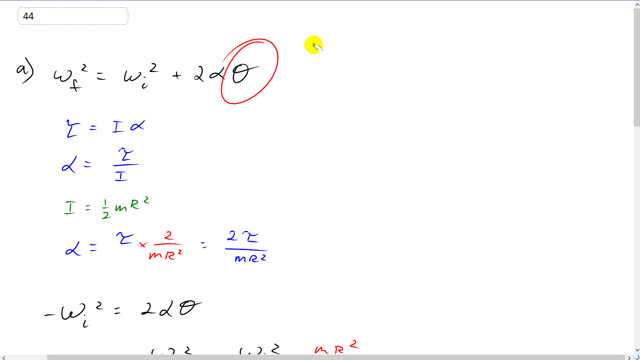
A centrifuge rotor rotating at 9200 rpm is shut off and is eventually brought uniformly to rest by a frictional torque of . If the mass of the rotor is 3.10 kg and it can be approximated as a solid cylinder of radius 0.0710 m, through how many revolutions will the rotor turn before coming to rest, and how long will it take?

In order to watch this solution you need to have a subscription.
This is Giancoli Answers with Mr. Dychko. The final angular velocity of the centrifuge squared equals its initial angular velocity plus 2 times its angular acceleration times the total angular displacement and so we are gonna be solving for Θ here in order to figure out the number of revolutions that it undergoes as it comes to a stop. So we know that torque is moment of inertia times angular accceleration and we can divide both sides by I to figure out α— that's gonna be helpful here— and so α is torque divided by moment of inertia. And moment of inertia for this uniform cylinder is one-half mass times its radius squared. So we'll divide by mR squared over 2 by multiplying by its reciprocal in this formula for α so multiply by 2 over mR squared so α is 2 times the torque divided by the mass times the radius squared. So we can return to this formula now and get rid of this term here because it comes to a stop so there's no final angular velocity. And then subtract ω i squared from both sides and we get negative ω i squared equals 2 times α times Θ. And we'll divide both sides by 2α and solve for Θ angular displacement and that's negative initial angular velocity squared divided by 2 times angular acceleration and we'll substitute for α by multiplying by its reciprocal instead of dividing by α, we'll multiply by reciprocal of α and the reciprocal of α is m squared over 2τ so we multiply by that and you are collecting all these factors together, we get 4 on the bottom—2 times 2 there— and well, we can just plug in numbers now: negative 9200 revolutions per minute times by 1 minute for every 60 seconds times 2π radians per revolution giving us radians per second there and then we square that initial angular velocity times 3.10 kilograms times 0.0710 meters and square that and then divide by 4 times negative 1.20 newton meters for torque; I put the sign of the torque negative because we have the initial angular velocity positive this negative here is from the algebra and so the torque should be in the opposite direction to the initial angular velocity and so on. Since the initial angular velocity is positive, we have the torque being negative and this makes this whole thing work out to be positive angular displacement in the same direction as the initial angular velocity. And then we times that by 1 revolution for every 2π radians because the questions asks us not for the number of radians that it undergoes but the number of revolutions and this all works out to about 480 revolutions in total as it comes to a stop. And then to figure out the amount of time it takes, we could use a formula involving this angular displacement but in order to be safe, let's not use a number that we have calculated but instead use formulas that involve only numbers that come from the question so we use provided data instead of calculated data. So the final angular velocity is initial angular velocity plus angular acceleration times time and ω f is 0 and we can subtract ω i from both sides and then divide both sides by α and we get the time is negative ω i over α. And so instead of dividing by α, we'll multiply by its reciprocal as we did up here so that's times mR squared over 2τ and so the total time is negative initial angular velocity times mass times radius squared divided by 2 times the torque. And substituting in numbers: we get 9200 revolutions per minute converted into radians per second times the mass times 0.0710 meters squared divided by 2 times negative 1.20 newton meters and we get about 6.3 seconds for the centrifuge to come to a stop.